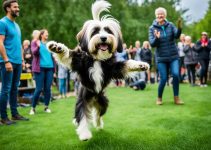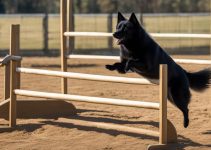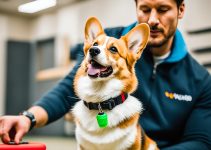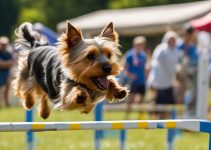Pugs are adorable and affectionate dogs, but their stubborn nature can make obedience training a challenge. To effectively train your pug, it’s important to start early, be consistent, use positive reinforcement, and set realistic expectations. Socialization and redirecting unwanted behaviors are also crucial aspects of pug training. Online training courses like SpiritDog’s “Perfect Obedience” and K9 Training Institute’s “Dog Masterclass” can provide additional guidance.
Pug Training Essentials
- Start pug training early to establish good habits and obedience.
- Consistency and positive reinforcement are key to successful training.
- Set realistic expectations and be patient with your pug’s learning process.
- Socialization helps pugs thrive in different situations and prevents behavioral issues.
- Consider online training courses for additional guidance and professional help.
Starting Early: Training Your Pug Puppy
When it comes to pug training, starting early is the key to success. As soon as you bring your pug puppy home, it’s important to begin teaching them basic obedience commands.
Consistency is crucial during this stage of training. Set a daily routine and stick to it, ensuring that your pug knows what to expect. This will help them develop good habits and understand your expectations.
- Use Positive Reinforcement: Pugs respond well to positive reinforcement. Whenever your pug follows a command correctly, reward them with praise and treats. This will motivate and encourage them to continue behaving well.
- Keep Training Sessions Short and Engaging: Pug puppies have short attention spans. Keep training sessions brief, around 10-15 minutes, and make them fun and engaging. Incorporate games and playtime to keep your pug excited and focused.
- House Training: To establish boundaries and prevent accidents in the house, start house training your pug puppy as soon as possible. Take them outside regularly, especially after meals, naps, and playtime. Reward them when they eliminate in the designated spot.
- Pug Crate Training: Crate training is an effective way to create a safe space for your pug and prevent destructive behaviors. Introduce your pug to the crate gradually, making it comfortable and inviting. Use treats and positive reinforcement to create a positive association with the crate.
Remember, pug puppies are like sponges and learn quickly, but they also have their own unique personalities. Be patient, consistent, and understanding as you navigate the ups and downs of pug puppy training. With time, effort, and love, your pug will grow into a well-behaved and happy companion.
Positive Reinforcement: A Powerful Tool for Pug Training
When it comes to pug training, positive reinforcement is a highly effective technique. By using positive reinforcement, you can motivate and encourage your pug to exhibit desirable behaviors. This approach involves rewarding your pug with praise, treats, or playtime whenever they perform the desired actions, such as following commands or displaying good behavior.
Positive reinforcement helps create a positive association in your pug’s mind between the behavior and the reward, making them more likely to repeat the behavior in the future. This method not only reinforces good habits but also strengthens the bond between you and your pug through trust and positive interactions.
To effectively use positive reinforcement, consistency is key. Consistently reward your pug every time they exhibit the desired behavior, and be sure to do so immediately after the behavior occurs. This helps your pug make the connection between their actions and the reward.
- Use verbal praise: Praise your pug enthusiastically with encouraging words such as “good job” or “well done” when they perform the desired behavior.
- Offer treats: Treats are a great incentive for pugs, and using them as rewards can be highly motivating. Choose small, bite-sized treats that your pug loves, and give them one as soon as they demonstrate the desired behavior.
- Engage in playtime: Many pugs love playtime, so incorporating it as a reward can be effective. After your pug obeys a command or exhibits good behavior, engage in a short play session as a reward.
Remember that pugs respond best to positive reinforcement, so be patient and avoid punishment-based methods that can damage the trust and relationship between you and your pug. With consistent and positive training, you can successfully teach your pug obedience and shape their behavior.
Now, let’s move on to the next section where we will discuss the importance of keeping training sessions short and engaging for pugs.
Training Sessions: Short and Sweet for Pugs
When it comes to training sessions for your pug, keeping them short and engaging is essential. Puppies, including pugs, have limited attention spans, so it’s important to optimize their training time for maximum effectiveness. By following a few key strategies, you can ensure that your pug remains focused and retains the information better.
First and foremost, keep your training sessions short, typically around 10-15 minutes. Pugs are known for their short attention spans, so shorter sessions can help prevent them from becoming bored or disinterested. This also allows you to maintain their focus throughout the session, enabling them to learn and understand the commands more effectively.
Additionally, it’s recommended to engage your pug in 2-3 training sessions a day. Spacing out the training throughout the day ensures that your pug has time to rest and process the information learned in each session. This approach helps prevent overload and enhances their ability to retain the training information.
Remember, quality over quantity is the key to successful training sessions for pugs. Focus on providing clear instructions and cues, and be patient with your pug’s progress. Celebrate their achievements and reward them with praise or treats when they respond correctly. This positive reinforcement not only motivates your pug but also strengthens the training bond between you and your furry friend.
By incorporating short and engaging training sessions into your pug’s routine, you can optimize their learning potential and help them develop good behavior. Consistency and patience are vital throughout the training process, as every pug learns at their own pace. Stay committed, and soon you’ll enjoy the benefits of a well-trained and obedient pug who brings joy to your life.
Clear Commands: The Language of Pug Training
When it comes to pug training, clear and simple commands are key to effective communication. Using one-word commands like sit, stay, down, and come helps your pug understand what is expected of them, fostering better obedience and behavior. By keeping the commands concise, you can avoid confusion and make the learning process smoother for your pug.
Using multiple words for the same command can easily confuse your pug, as they may not be able to distinguish between different variations. For example, using “lie down” instead of “down” might lead to inconsistency and hinder progress. Stick to the simplest and most straightforward commands to ensure that your pug understands what you want them to do.
As you teach your pug obedience, remember to be patient and consistent in your training approach. Focus on using clear commands that are easy for your pug to understand, and pair them with positive reinforcement such as treats or praise. This combination will help reinforce the desired behavior and strengthen the bond between you and your pug.
For a visual guide on pug training commands, refer to the image below:
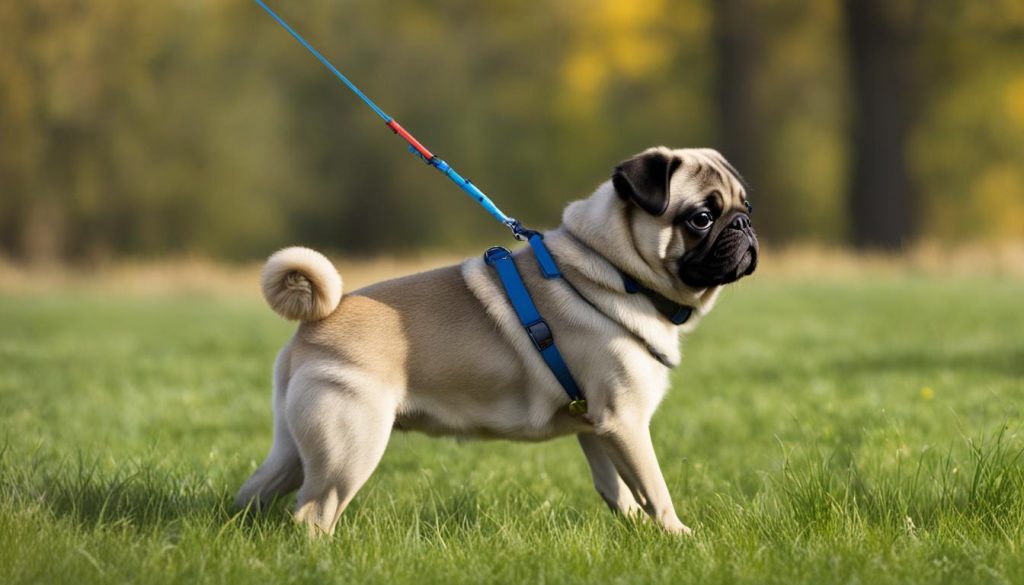
By incorporating clear commands into your pug training routines, you can effectively communicate with your furry friend and ensure a positive learning experience for both of you. Remember, simplicity is key when it comes to teaching your pug obedience commands and building a strong foundation for their training journey.
Patience Pays Off: Training Your Pug with Patience
When it comes to training your pug, patience is absolutely essential. It’s important to remember that your pug is still in the learning process and may not grasp new commands immediately. As a responsible trainer, staying calm and composed during training sessions is crucial.
Allow your pug the time they need to understand and respond to the training. Every puppy is unique, and some may take longer to learn than others. By approaching training with patience, you’ll create a positive and supportive environment that motivates your pug to keep trying and learning.
During training, focus on building a strong bond with your pug. Positive reinforcement is highly effective, so remember to praise and reward your pug when they exhibit the desired behavior. A simple “good job” or a treat can go a long way in reinforcing their understanding and willingness to learn.
Remember, pug training is a gradual process, and progress may not always be linear. Some days may be better than others, but consistency and patience will pay off in the long run. Celebrate small victories and focus on incremental improvements, as these are the building blocks of successful training.
So, the next time you find yourself getting frustrated or overwhelmed during a training session, take a deep breath and remind yourself of the power of patience. Trust the process and believe in your pug’s ability to learn and grow. With time and dedication, you’ll witness the incredible growth and development of your well-trained pug companion.
Socialization: Helping your Pug Thrive in Different Situations
Socialization is a critical aspect of pug training that plays a vital role in shaping your pug’s behavior and temperament. By exposing your pug to various environments, people, and other animals, you can help them develop confidence and learn appropriate behavior in different situations.
Proper socialization can also prevent behavioral issues like aggression and fearfulness in the future. By introducing your pug to different experiences from a young age and continuing socialization throughout their lives, you can lay a solid foundation for their emotional well-being.
During socialization, gradually expose your pug to new environments, such as parks, busy streets, and different types of surfaces. Allow them to interact with well-behaved dogs and people of all ages. This exposure helps your pug become familiar with different sights, sounds, and smells, reducing the likelihood of fear or anxiety in unfamiliar situations.
When socializing your pug, always prioritize their safety and comfort. Start with controlled environments, such as puppy socialization classes or supervised playdates with other friendly dogs. Ensure that the interactions are positive and rewarding for your pug, reinforcing their confidence and teaching appropriate social behavior.
Remember to observe your pug’s reactions and body language during socialization. If your pug shows signs of fear or discomfort, like cowering, trembling, or excessive panting, provide reassurance and remove them from the situation. Gradually reintroduce them to similar situations in a more controlled and supportive manner, helping them build confidence over time.
It’s important to note that socialization is an ongoing process. Continuing to expose your pug to new experiences, environments, and social interactions throughout their lives will help maintain their confidence and prevent regression.
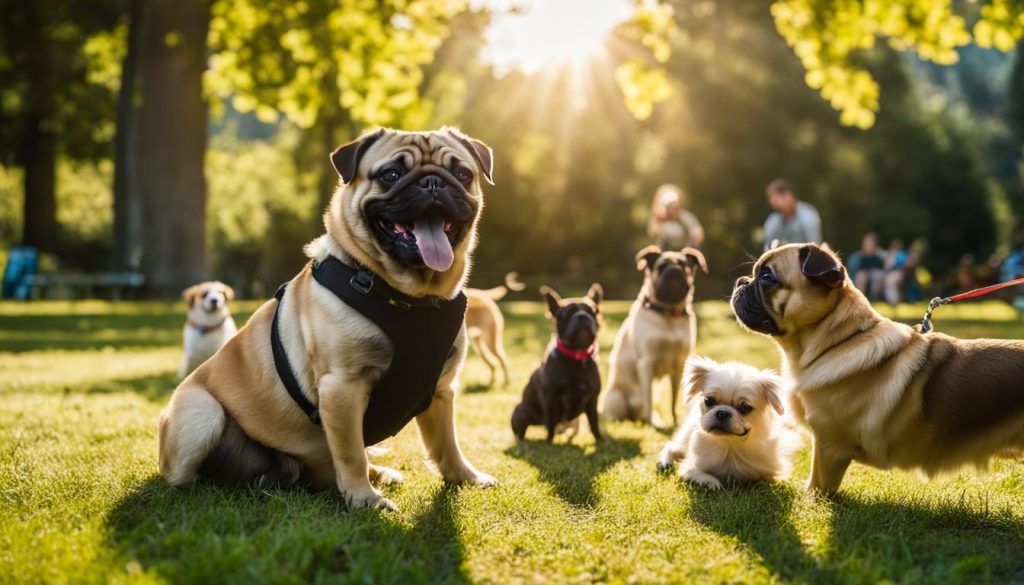
Conclusion: Building a Strong Bond through Pug Training
Training a pug requires patience, dedication, and consistency. By following the essential tips outlined in this article, you can help your pug develop good habits and improve their behavior. Remember to use positive reinforcement, set realistic expectations, and tailor your training approach to your pug’s unique personality. Seeking professional help, such as a professional pug trainer, or enrolling in online training courses can also be beneficial.
With time and effort, you can enjoy a happy and well-behaved pug who brings joy to your life every day. Implementing pug training techniques and using tricks to train pugs, you can build a strong bond with your furry companion. Whether it’s teaching basic commands, house training, or addressing behavior issues, consistency and positive reinforcement are key.
Remember, building a strong bond with your pug goes beyond just training. It’s important to spend quality time together, provide mental stimulation, and shower them with love and attention. With the right approach, patience, and understanding, your pug can become a well-rounded and obedient member of your family.
FAQ
How can I effectively train my pug?
To effectively train your pug, it’s important to start early, be consistent, use positive reinforcement, and set realistic expectations. Socialization and redirecting unwanted behaviors are also crucial aspects of pug training.
What are some tips for training a pug puppy?
Start early by teaching basic obedience commands, be consistent, use positive reinforcement, and focus on house training and crate training to establish boundaries and prevent accidents.
How can positive reinforcement help in pug training?
Positive reinforcement, such as rewarding your pug with praise, treats, or playtime, encourages them to repeat desired behaviors and strengthens the bond between you and your pug.
How long should training sessions be for pugs?
Training sessions for pugs should be short, around 10-15 minutes, and conducted 2-3 times a day to ensure focus and better retention of information.
What kind of commands should I use in pug training?
Stick to clear and simple one-word commands like sit, stay, down, and come to improve communication and avoid confusing your pug.
Is patience important in pug training?
Patience is crucial when training a pug, as they may take time to grasp new commands. Stay calm and allow your pug to understand and respond at their own pace.
Why is socialization important in pug training?
Socialization helps pugs develop confidence and learn appropriate behavior in various situations, preventing future issues like aggression and fearfulness. It is crucial to expose your pug to different experiences from a young age.
What are some key takeaways from pug training?
Training a pug requires patience, consistency, and dedication. Positive reinforcement, realistic expectations, and tailoring the training approach to your pug’s personality are important. Seeking professional help, such as online training courses, can also be beneficial.

